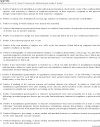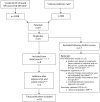Clinical prediction rules for physical therapy interventions: a systematic review
- PMID: 19095806
- PMCID: PMC2636674
- DOI: 10.2522/ptj.20080239
Clinical prediction rules for physical therapy interventions: a systematic review
Abstract
Background and purpose: Clinical prediction rules (CPRs) involving physical therapy interventions have been published recently. The quality of the studies used to develop the CPRs was not previously considered, a fact that has potential implications for clinical applications and future research. The purpose of this systematic review was to determine the quality of published CPRs developed for physical therapy interventions.
Methods: Relevant databases were searched up to June 2008. Studies were included in this review if the explicit purpose was to develop a CPR for conditions commonly treated by physical therapists. Validated CPRs were excluded from this review. Study quality was independently determined by 3 reviewers using standard 18-item criteria for assessing the methodological quality of prognostic studies. Percentage of agreement was calculated for each criterion, and the intraclass correlation coefficient (ICC) was determined for overall quality scores.
Results: Ten studies met the inclusion criteria and were included in this review. Percentage of agreement for individual criteria ranged from 90% to 100%, and the ICC for the overall quality score was .73 (95% confidence interval=.27-.92). Criteria commonly not met were adequate description of inclusion or exclusion criteria, inclusion of an inception cohort, adequate follow-up, masked assessments, sufficient sample sizes, and assessments of potential psychosocial factors. Quality scores for individual studies ranged from 48.2% to 74.0%.
Discussion and conclusion: Validation studies are rarely reported in the literature; therefore, CPRs derived from high-quality studies may have the best potential for use in clinical settings. Investigators planning future studies of physical therapy CPRs should consider including inception cohorts, using longer follow-up times, performing masked assessments, recruiting larger sample sizes, and incorporating psychological and psychosocial assessments.
Figures



Comment in
-
On "clinical prediction rules for physical therapy interventions..." Beneciuk JM, et al. Phys Ther. 2009;89:114-124.Phys Ther. 2009 Apr;89(4):394; author reply 394-5. doi: 10.2522/ptj.2009.89.4.394.1. Phys Ther. 2009. PMID: 19339250 No abstract available.
References
-
- Childs JD, Cleland JA. Development and application of clinical prediction rules to improve decision making in physical therapist practice. Phys Ther. 2006;86:122–131. - PubMed
-
- Cook C. Potential pitfalls of clinical prediction rules [editorial]. J Man Manip Ther. 2008;16:69–71. - PubMed
-
- McGinn TG, Guyatt GH, Wyer PC, et al. Users’ guides to the medical literature, XXII: how to use articles about clinical decision rules. Evidence-Based Medicine Working Group. JAMA. 2000;284:79–84. - PubMed
-
- McGinn TG, Guyatt GH, Wyer PC, et al. Diagnosis: clinical prediction rule. In: Guyatt GH, Rennie D, eds. Users’ Guide to the Medical Literature: A Manual for Evidence-Based Clinical Practice. Chicago, IL: AMA Press; 2002:471–483.
Publication types
MeSH terms
Grants and funding
LinkOut - more resources
Full Text Sources
Miscellaneous

